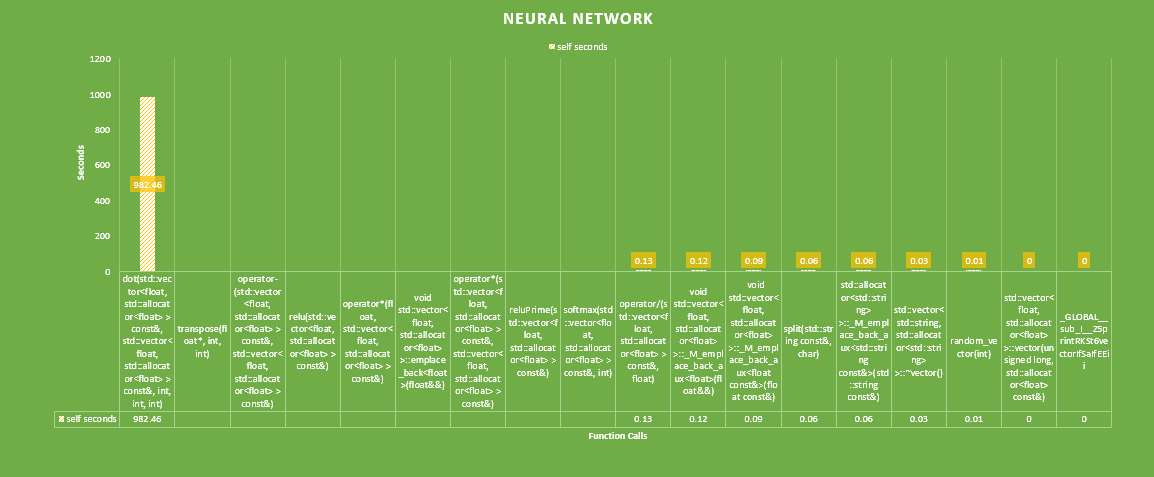Difference between revisions of "A-Team"
Spdjurovic (talk | contribs) (→Sebastian's findings) |
Spdjurovic (talk | contribs) (→Initial Profile) |
||
| Line 41: | Line 41: | ||
[[File:neuralnet_chart.jpg]] | [[File:neuralnet_chart.jpg]] | ||
| + | |||
| + | After the initial profile it is obvious that the dot product function consumes 97.94% of our run time. Additionally, the transpose function also consumes 1.45% which seems messily, however during back propagation transpose is also called. | ||
| + | |||
| + | // Back propagation | ||
| + | vector<float> dyhat = (yhat - b_y); | ||
| + | // dW3 = a2.T * dyhat | ||
| + | vector<float> dW3 = dot(transpose( &a2[0], BATCH_SIZE, 64 ), dyhat, 64, BATCH_SIZE, 10); | ||
| + | // dz2 = dyhat * W3.T * relu'(a2) | ||
| + | vector<float> dz2 = dot(dyhat, transpose( &W3[0], 64, 10 ), BATCH_SIZE, 10, 64) * reluPrime(a2); | ||
| + | // dW2 = a1.T * dz2 | ||
| + | vector<float> dW2 = dot(transpose( &a1[0], BATCH_SIZE, 128 ), dz2, 128, BATCH_SIZE, 64); | ||
| + | // dz1 = dz2 * W2.T * relu'(a1) | ||
| + | vector<float> dz1 = dot(dz2, transpose( &W2[0], 128, 64 ), BATCH_SIZE, 64, 128) * reluPrime(a1); | ||
| + | // dW1 = X.T * dz1 | ||
| + | vector<float> dW1 = dot(transpose( &b_X[0], BATCH_SIZE, 784 ), dz1, 784, BATCH_SIZE, 128); | ||
=====Ray Tracing===== | =====Ray Tracing===== | ||
Revision as of 09:27, 8 March 2019
Contents
Back Propagation Acceleration
Team Members
- Sebastian Djurovic, Team Lead and Developer
- Henry Leung, Developer and Quality Control
- ...
Progress
Assignment 1
Our group decided to profile a couple of different solutions, the first being a simple neural network and ray tracing solution, in order to determine the best project to generate a solution for.
Neural Network
Sebastian's findings
I found a simple neural network that takes a MNIST data set and preforms training on batches of the data. For a quick illustration MNIST is a numerical data set that contains many written numbers --in a gray scale format at 28 x 28 pixels in size. As well as the corresponding numerical values; between 0 and 9. The reason for this data set is to train networks such that they will be able to recognize written numbers when they are confront them.
Initial Profile
Flat profile: Each sample counts as 0.01 seconds. % cumulative self self total time seconds seconds calls ns/call ns/call name 97.94 982.46 982.46 dot(std::vector<float, std::allocator<float> > const&, std::vector<float, std::allocator<float> > const&, int, int, int) 1.45 997.05 14.58 transpose(float*, int, int) 0.15 998.56 1.51 operator-(std::vector<float, std::allocator<float> > const&, std::vector<float, std::allocator<float> > const&) 0.15 1000.06 1.50 relu(std::vector<float, std::allocator<float> > const&) 0.15 1001.55 1.49 operator*(float, std::vector<float, std::allocator<float> > const&) 0.07 1002.27 0.72 519195026 1.39 1.39 void std::vector<float, std::allocator<float> >::emplace_back<float>(float&&) 0.06 1002.91 0.63 operator*(std::vector<float, std::allocator<float> > const&, std::vector<float, std::allocator<float> > const&) 0.05 1003.37 0.46 reluPrime(std::vector<float, std::allocator<float> > const&) 0.02 1003.62 0.25 softmax(std::vector<float, std::allocator<float> > const&, int) 0.01 1003.75 0.13 operator/(std::vector<float, std::allocator<float> > const&, float) 0.01 1003.87 0.12 442679 271.35 271.35 void std::vector<float, std::allocator<float> >::_M_emplace_back_aux<float>(float&&) 0.01 1003.96 0.09 13107321 6.87 6.87 void std::vector<float, std::allocator<float> >::_M_emplace_back_aux<float const&>(float const&) 0.01 1004.02 0.06 split(std::string const&, char) 0.01 1004.08 0.06 462000 130.00 130.00 void std::vector<std::string, std::allocator<std::string> >::_M_emplace_back_aux<std::string const&>(std::string const&) 0.00 1004.11 0.03 std::vector<std::string, std::allocator<std::string> >::~vector() 0.00 1004.12 0.01 random_vector(int) 0.00 1004.12 0.00 3 0.00 0.00 std::vector<float, std::allocator<float> >::vector(unsigned long, std::allocator<float> const&) 0.00 1004.12 0.00 1 0.00 0.00 _GLOBAL__sub_I__Z5printRKSt6vectorIfSaIfEEii
After the initial profile it is obvious that the dot product function consumes 97.94% of our run time. Additionally, the transpose function also consumes 1.45% which seems messily, however during back propagation transpose is also called.
// Back propagation
vector<float> dyhat = (yhat - b_y);
// dW3 = a2.T * dyhat
vector<float> dW3 = dot(transpose( &a2[0], BATCH_SIZE, 64 ), dyhat, 64, BATCH_SIZE, 10);
// dz2 = dyhat * W3.T * relu'(a2)
vector<float> dz2 = dot(dyhat, transpose( &W3[0], 64, 10 ), BATCH_SIZE, 10, 64) * reluPrime(a2);
// dW2 = a1.T * dz2
vector<float> dW2 = dot(transpose( &a1[0], BATCH_SIZE, 128 ), dz2, 128, BATCH_SIZE, 64);
// dz1 = dz2 * W2.T * relu'(a1)
vector<float> dz1 = dot(dz2, transpose( &W2[0], 128, 64 ), BATCH_SIZE, 64, 128) * reluPrime(a1);
// dW1 = X.T * dz1
vector<float> dW1 = dot(transpose( &b_X[0], BATCH_SIZE, 784 ), dz1, 784, BATCH_SIZE, 128);

